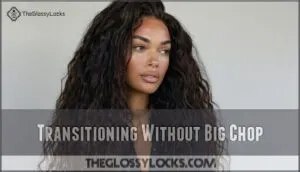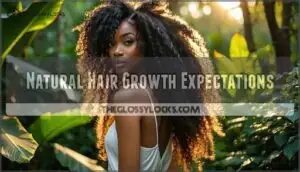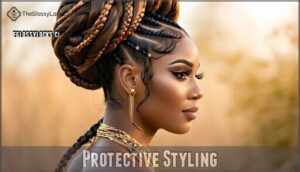This site is supported by our readers. We may earn a commission, at no cost to you, if you purchase through links.
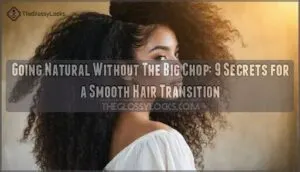
Going natural without the big chop means gradually evolving while keeping your length.
You’ll work with two textures—your natural roots and processed ends—using protective styles like twists, braids, or buns to blend them seamlessly.
Regular trims, deep conditioning, and minimal heat are your best friends during this process.
It’s like renovating a house room by room instead of demolishing it all at once.
Your patience will be tested, but watching your curls emerge while maintaining length is worth the extra effort.
The secret lies in finding the right evolution styles that work for your unique texture, and this process requires minimal heat, regular trims, and deep conditioning to ensure a healthy transition.
Table Of Contents
- Key Takeaways
- Transitioning Without Big Chop
- Natural Hair Growth Expectations
- Managing Transition Challenges
- 9 Best Products for Natural Hair
- 1. Healthy Beautiful Natural Hair Guide
- 2. Camille Rose Curl Maker Gel
- 3. Pantene Gold Series Hair Kit
- 4. Camille Rose Algae Hair Mask
- 5. Head Shoulders Royal Oils Scalp Cream
- 6. Curls Blueberry Bliss Twist Out Cream
- 7. SheaMoisture Coconut Oil Skin and Hair
- 8. Leven Rose Organic Jojoba Oil
- 9. BESTOOL Detangling Brush for Natural Hair
- Maintaining Healthy Natural Hair
- Frequently Asked Questions (FAQs)
- Can you go natural without big chops?
- What is an alternative to the big chop?
- Is Big Chop necessary?
- How can I determine which hair products are best for my transitioning hair?
- Can I color my hair while transitioning, and if so, what are the safest methods?
- How to manage night routines for transitioning hair?
- Can medications affect the transition process?
- How to handle postpartum shedding while transitioning?
- Swimming pool care for transitioning hair?
- When should you consider professional help?
- Conclusion
Key Takeaways
- You’ll manage two textures by blending natural roots with processed ends using protective styles like twists and braids.
- Regular trims, deep conditioning, and minimal heat are essential for maintaining healthy transitioning hair.
- Patience is key—embrace gradual change and avoid comparing your journey to others.
- Avoid chemical treatments and prioritize protective styles, moisturizing products, and a balanced diet for optimal hair health.
Transitioning Without Big Chop
You can embrace your natural texture without sacrificing length by gradually growing out your relaxed hair.
This patient approach lets you maintain your current length while your natural roots emerge, giving you time to learn about your new texture before fully committing to your natural texture and understanding your new texture.
Physical and Mental Components
Embracing the natural hair journey involves two distinct paths.
The physical transformation means growing out your relaxed hair while nurturing new growth, which requires texture management and proper product selection.
Meanwhile, the mental transformation demands patience as you adapt to unfamiliar patterns and styling challenges.
Many naturals find this psychological shift equally challenging, requiring mental preparation for the days when your progressing hair seems uncooperative.
With time, both aspects become easier to manage, and this realization can bring a sense of accomplishment.
No Set Time Limit
While the mental side shapes your approach, your hair transformation process follows no universal schedule.
Personal timelines vary widely—some people need just 4 months while others take 18+ months to complete their journey.
Your individual journey depends on hair growth rates, starting length, and ultimate goals.
Don’t compare your regrowing hair to others; everyone’s physical transformation unfolds at its own perfect pace, influenced by factors such as starting length and ultimate goals.
Patience and Commitment Required
While there’s no fixed timeframe, your hair transformation process demands serious staying power.
You’ll need mental fortitude to manage two textures simultaneously and avoid discouragement when progress seems slow.
Establish consistent routines for transforming hair, including regular hair trimming every 4-6 weeks.
Set a realistic timeline based on your starting length and celebrate small milestones along the way.
The alternative, a fresh start option, involves cutting off all chemically treated hair.
Remember: patience isn’t just helpful—it’s absolutely necessary.
Natural Hair Growth Expectations
Your hair grows about half an inch per month, but it’s important to remember that perfect length retention isn’t always realistic.
Understanding your unique growth rate will help you set achievable goals and stay patient throughout the process, which is key to successful hair growth.
Average Hair Growth Rate
You’ll typically see your hair grow about ½ inch per month, which adds up to approximately 6 inches yearly.
Your personal hair growth rate can vary based on factors like genetics, age, and even seasons – many notice faster growth during summer months.
Understanding your unique growth cycle helps set realistic expectations as you work toward your natural hair goals.
Perfect Length Retention
While hair grows steadily, perfect length retention is actually achievable with consistent care.
You’ll need to minimize breakage through protective hairstyles and gentle detangling methods.
Good scalp health and smart product selection help evolving hair maintain its progress.
Focus on length retention by incorporating low manipulation styles to prevent hair breakage at the line between textures.
Regular moisturizing and proper handling keep your new growth intact and thriving, which is key to length retention.
Individual Hair Growth Rates
In the process of your natural hair journey, understanding that hair growth rates vary widely among individuals is essential.
Your unique growth pattern depends on:
- Genetic predisposition (the strongest factor affecting your hair growth timeline)
- Scalp health and blood circulation
- Seasonal variation (faster growth typically occurs in summer)
- Age influence (growth often slows as you get older)
Knowing your personal growth rate helps set realistic hair growth expectations for your journey.
Managing Transition Challenges
You’ll face the challenge of managing two different hair textures during your journey, but don’t worry—it’s completely normal.
With the right techniques and a positive mindset, you can successfully navigate this temporary phase.
While your natural curls make their gradual comeback, having the right approach is crucial, and maintaining a positive mindset throughout the process is key.
Simultaneous Textures
While growing out your natural hair, you’ll face the reality of managing two different textures at once.
This "two-worlds" phase can be challenging but completely manageable with the right approach.
Understanding your hair’s texture classification can substantially aid in selecting the right products and techniques.
| Texture Challenge | Management Technique | Products That Help |
|---|---|---|
| Line of demarcation breakage | Gentle detangling | Slippery detangling conditioners |
| Styling inconsistency | Twist-outs or braid-outs | Curl-defining creams |
| Moisture imbalance | Deep conditioning | Leave-in conditioners with oils |
| Different curl patterns | Protective styling | Edge control and styling gels |
| Conflicting product needs | Product cocktailing | Multi-benefit hair masks |
Mental Preparation
Beyond managing different hair textures, your mindset needs preparation too.
The natural hair journey requires patience development and realistic expectations.
You’ll face moments of doubt, so build hair confidence early.
Join online communities for support—they understand your challenges firsthand.
Remember, this mental shift is as important as physical changes.
Develop stress management techniques for frustrating days.
Self-image acceptance comes gradually, but it’s worth every step of your natural hair journey.
Beneficial Hair Care Practices
Now that your mind is ready, let’s focus on what your hands should be doing. Your hair in a state of change needs specific care practices to thrive.
Here are three game-changers for your journey:
- Gentle detangling with wide-tooth combs on wet, conditioned hair
- Night protection using silk or satin pillowcases to prevent breakage
- Moisture retention through regular deep conditioning and minimal heat styling
These habits will strengthen your natural hair while safeguarding fragile ends. Many find that a detangling comb selection is essential.
9 Best Products for Natural Hair
You’ll need the right products to help your hair thrive during the shift from relaxed to natural.
These nine quality items will nourish your strands and make managing both textures much easier while you grow out your hair.
1. Healthy Beautiful Natural Hair Guide

Dr. Phoenyx Austin’s book "If You Love It, It Will Grow" serves as your essential roadmap to natural hair success.
This 222-page guide focuses specifically on growing and maintaining healthy afro-textured hair while addressing common issues like breakage.
You’ll appreciate the holistic approach that combines hair care with self-love principles.
The book includes practical advice for creating a flexible, lifelong hair regimen alongside beauty smoothie recipes for internal hair health.
Many readers value Dr. Austin’s combination of personal experience and professional expertise in both fitness and natural hair care.
Best For: Individuals with afro-textured hair seeking a holistic approach to hair care, self-love, and sustainable growth.
- Focuses on practical, lifelong hair care routines tailored to afro-textured hair.
- Combines hair care tips with self-esteem and overall wellness principles.
- Includes smoothie recipes for enhanced internal hair health.
- Primarily geared towards afro-textured hair, limiting applicability for other hair types.
- Requires consistent effort and lifestyle changes to see results.
- Avoids heat styling, which may not suit everyone’s preferences.
2. Camille Rose Curl Maker Gel
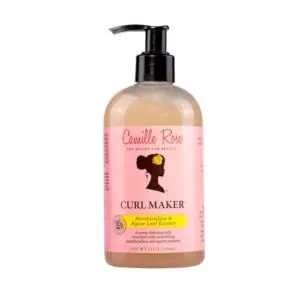
With Camille Rose Curl Maker Gel, your journey to natural hair becomes substantially easier.
This popular product defines and smooths curls using marshmallow root, which helps detangle those challenging two-texture sections.
The aloe and nettle root ingredients nourish your hair while providing essential moisture.
For best results, apply generously to wet, detangled hair from root to tip.
It offers soft-to-medium hold without leaving that crunchy feeling many gels create.
Pair it with Curl Love Moisture Milk for enhanced definition.
Users particularly praise its ability to reduce frizz while maintaining natural curl patterns throughout your journey.
Best For: Individuals with curly, coily, or kinky hair textures looking for natural curl definition and frizz reduction.
- Defines curls while reducing frizz and enhancing natural patterns.
- Soft to medium hold without a crunchy feel.
- Nourishes hair with natural ingredients like marshmallow root and aloe.
- Some users report issues with stickiness.
- Product quality may vary depending on the retailer.
- Not explicitly marketed as a volumizing product.
3. Pantene Gold Series Hair Kit
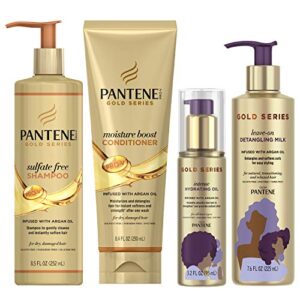
Pamper your evolving hair with the Pantene Gold Series Hair Kit.
This extensive set includes an 8.5 fl oz sulfate-free shampoo and 8.4 fl oz conditioner specifically designed for textured hair.
Infused with argan oil and Pro-V nutrients, these products help tame frizz, detangle curls, and strengthen hair against breakage.
The leave-on detangling milk provides additional moisture while prepping your strands for styling.
Users particularly praise its effectiveness for 4c hair, noting the excellent slip for easy detangling and its ability to leave hair clean, soft, and manageable.
Best For: Individuals with textured, frizzy, dry, or curly hair, especially those with 4c hair seeking hydration, softness, and manageability.
- Sulfate-free, paraben-free, and dye-free formula.
- Effectively detangles and softens curls with excellent slip.
- Strengthens hair against breakage and enhances shine.
- Manufactured in China, which may concern some buyers.
- Caution needed to avoid using too much product.
- May not cater to non-textured or very fine hair types.
4. Camille Rose Algae Hair Mask
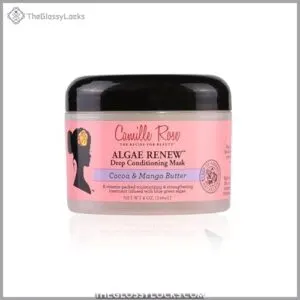
This deep conditioning treatment from Camille Rose works wonders for hair in a state of change.
The blue-green algae strengthens your strands while preventing thinning and breakage. Mango butter locks in moisture, making it perfect for managing both relaxed and natural textures simultaneously.
Apply to wet or dry hair for 10 minutes, or use with heat for deeper conditioning. For best results, pair it with Camille Rose’s Sweet Ginger Rinse Shampoo.
Users consistently report softer, more manageable curls with reduced frizz. One should also consider avoiding harsh chemicals for healthier hair. Though the price point is higher, a little goes a long way, making it a worthwhile investment for softer and more manageable curls with reduced frizz.
Best For: Those with dry, curly, coily, or damaged hair looking for intense hydration, improved manageability, and reduced frizz.
- Packaging design is inefficient and environmentally wasteful.
- Higher price point compared to similar products.
- Some users reported product build-up over time.
- Deeply moisturizes and strengthens hair with blue-green algae and mango butter.
- Reduces frizz and improves curl softness and manageability.
- Safe for sensitive scalps and fragrance-sensitive individuals.
5. Head Shoulders Royal Oils Scalp Cream
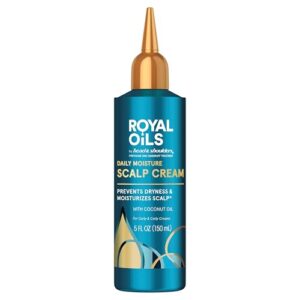
Many individuals embracing natural hair struggle with scalp issues, making Head & Shoulders Royal Oils Scalp Cream a game-changer for your journey.
This leave-in treatment seals moisture and prevents flaking and itching without rinsing, developed specifically for Black hair by Black scientists, it’s sulfate-free and infused with menthol and peppermint oils that provide an immediate cooling sensation.
You’ll love how it extends your hairstyle’s life while reducing washing frequency, and with its ability to provide 24-hour protection, you can enjoy healthier natural hair.
Apply directly to your scalp with the nozzle tip up to four times daily for a healthier natural hair experience.
Best For: Individuals with natural, relaxed, kinky, or coily hair looking for a leave-in scalp treatment to address itching, flakes, and dryness while extending hairstyle longevity.
- Provides 24-hour scalp nourishment and moisture.
- Lightweight, non-greasy formula with a refreshing scent.
- Easy-to-use nozzle tip for direct application and quick relief.
- Packaging issues may make it harder to extract the product.
- May be costly for regular use, especially for severe dryness.
- Small size (4.2 fl oz) can be used up quickly with frequent application.
6. Curls Blueberry Bliss Twist Out Cream
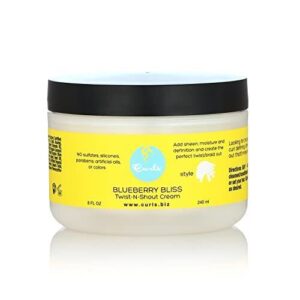
When making the switch to natural hair, Curls Blueberry Bliss Twist Out Cream becomes your secret weapon for defined, moisturized curls.
This lightweight cream contains blueberry extract, aloe leaf juice, and nourishing oils that work together to enhance your natural curl pattern without weighing it down.
You’ll appreciate its versatility for twist-outs and braid-outs across various curl types from 3B to 4C.
Apply it section by section to damp hair, style as desired, and let dry completely before unraveling, and note that it’s sulfate and silicone-free, making it perfect for your natural hair journey.
Best For: Individuals with curly hair types (3B to 4C) seeking defined, moisturized twist-outs and braid-outs without the use of sulfates or silicones.
- Enhances natural curl pattern with lightweight, non-greasy moisture.
- Versatile for twist-outs, braid-outs, and various curl types.
- Free from sulfates, silicones, and parabens for natural hair care.
- Fragrance intensity may not suit everyone.
- Higher price point when part of a full hair care routine.
- May require additional products for optimal moisture in certain hair types.
7. SheaMoisture Coconut Oil Skin and Hair
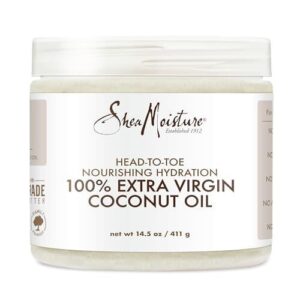
This versatile coconut oil magic serves as your all-in-one solution during transformation.
SheaMoisture’s 100% Virgin Coconut Oil product works double-duty for both skin and hair, helping retain moisture without leaving greasy residue.
It’s particularly effective on dry ends where relaxed hair meets natural growth, and you’ll appreciate its fast-absorbing formula that softens and restores your regrowing strands.
Free from harsh chemicals like parabens and sulfates, this multi-benefit moisturizer can be used as a hair treatment, styling aid, or makeup remover.
The antioxidant-rich formula leaves your hair and skin naturally radiant.
Best For: Individuals with dry or combination skin and hair looking for a versatile, multi-benefit moisturizer free from harsh chemicals.
- Multi-purpose use for hair, skin, and makeup removal.
- Fast-absorbing, non-greasy formula.
- Free from parabens, sulfates, and phthalates.
- May clog pores if overused on the scalp.
- Not ideal for oily skin types.
- Can be pricier compared to basic coconut oils.
8. Leven Rose Organic Jojoba Oil
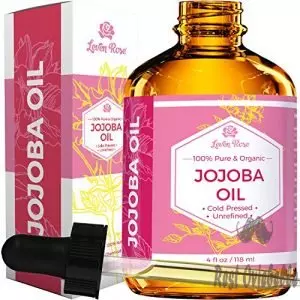
This organic jojoba oil is your hair’s best friend during the growth phase.
It mimics your scalp’s natural oils, providing deep moisture without feeling greasy.
The cold-pressed formula preserves all natural antioxidants while strengthening fragile strands at the line of demarcation.
Apply it to your ends to reduce breakage or massage into your scalp to balance oil production.
The amber glass bottle with dropper makes application precise and prevents oxidation.
One 4oz bottle lasts months since you’ll only need a few drops each time.
It’s also cruelty-free and paraben-free, making it a great choice for those looking for a gentle and effective hair care product.
Best For: People seeking a natural, multi-purpose moisturizer for hair, skin, and nails, especially those with sensitive or oily skin.
- Lightweight and non-greasy, suitable for all hair and skin types.
- Cruelty-free, paraben-free, and made with 100% organic ingredients.
- Cold-pressed formula retains antioxidants and essential nutrients.
- Some users find the oil aroma lingers on clothing or in rooms.
- Requires careful rinsing to avoid greasiness when used as a cleanser.
- Not as effective as bi-phase makeup removers for heavy makeup.
9. BESTOOL Detangling Brush for Natural Hair
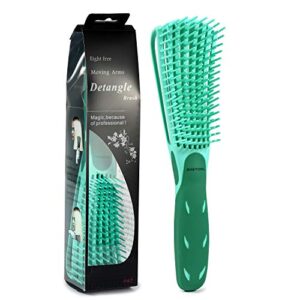
A revolution for transforming hair, the BESTOOL Detangling Brush features 8 flexible comb arms that reduce detangling time by 70% and hair damage by 80%.
You’ll appreciate how it effortlessly glides through both wet and dry curly, kinky, and coily textures. Its ergonomic rubberized handle provides a comfortable grip, even with wet hands.
Specifically designed for 3/4abc hair types, this brush is ideal for managing the challenging dual-texture phase of transformation. When paired with a detangling spray or leave-in conditioner, it’s particularly effective at gently separating knots without disturbing your natural curl pattern.
Best For: Individuals with 3/4abc textured curly, kinky, or coily hair looking for a gentle detangling solution that reduces time and hair damage.
- Reduces detangling time by 70% and hair damage by 80%.
- Comfortable, ergonomic handle for easy use, even with wet hands.
- Works effectively on both wet and dry hair without disturbing curl patterns.
- Slightly higher price compared to some alternatives.
- Requires patience for severely tangled hair despite reduced pain.
- Limited color options for those seeking variety.
Maintaining Healthy Natural Hair
You’ll need to protect your progressing hair with regular trims and minimal heat exposure while nourishing it from both inside and out.
Embrace protective styles like twists or braids to reduce manipulation, and don’t forget that a balanced diet rich in nutrients will support your hair’s health as you journey from relaxed to natural.
Protective Styling
Tucking away those fragile ends during your hair transformation process can make all the difference.
Protective styling shields your evolving hair from environmental damage while minimizing manipulation.
Braids, twists, and updos help prevent breakage at the delicate line where your natural and relaxed textures meet.
For ideal style longevity and scalp health, avoid tension concerns by ensuring styles aren’t too tight and address product buildup with regular cleansing.
Many people find specialty hair products useful during this protective styling process, which aids in hair transformation and promotes style longevity.
Trimming for Healthy Growth
While protective styles shield your hair from damage, regular trims are just as important for healthy growth.
Schedule professional trims every 8-12 weeks to prevent split ends from traveling up the hair shaft. Your hair’s elasticity improves when damaged ends are removed.
For ideal results, consider trimming natural hair every three months. Can’t visit a salon? DIY trimming with sharp hair scissors works too—just snip 1/4 inch to maintain length while promoting healthier regrowing hair.
Minimizing Heat Usage
Regular trimming keeps your ends healthy, but that’s only half the battle.
Heat styling can sabotage your natural hair journey by causing irreversible damage to your growing curls.
You’ll spot heat damage signs when your curls refuse to bounce back. Embrace air drying benefits and low heat styling techniques instead.
When you must use heat, apply a quality heat protectant first to prevent hair breakage and maintain your hair’s integrity. Many people prefer to use natural hair products for heat protection.
Avoiding Chemical Treatments
While you’re letting your natural texture emerge, keep all chemicals at arm’s length.
Say goodbye to relaxers, texturizers, keratin treatments, and permanent dyes—they’ll only sabotage your natural hair journey.
These products alter your hair’s structure, creating a confusing mix of textures and increasing breakage at the demarcation line.
Even "no-lye" formulas cause significant chemical damage.
For big chop avoidance success, this chemical-free commitment is non-negotiable.
Eating a Balanced Diet for Hair Health
Now that you’ve eliminated chemical treatments, let’s focus on your plate. Your hair literally grows from what you eat!
Boost natural hair growth with protein-rich foods like eggs and fatty fish. Combat nutrient deficiencies by including dark leafy greens, nuts, and sweet potatoes in your meals.
Don’t forget hydration effects—drink 64 oz of water daily to prevent breakage. Proper vitamin intake supports scalp health and creates the foundation for strong, thriving curls.
Frequently Asked Questions (FAQs)
Can you go natural without big chops?
Like a butterfly’s gradual metamorphosis, you can absolutely evolve to natural hair without big chops.
With patience, proper care techniques, and protective styling, you’ll grow out your relaxed hair while nurturing new growth underneath.
What is an alternative to the big chop?
You can gradually trim your relaxed ends over time with mini-chops every few months.
This phased method requires patience but allows you to maintain length while your natural texture grows in.
Is Big Chop necessary?
The big chop isn’t necessary for your natural hair journey. You can progress gradually by trimming relaxed ends over time while growing out your natural texture. It’s entirely your choice.
How can I determine which hair products are best for my transitioning hair?
Test products on small sections to see what works for your hair type.
Focus on moisturizing, sulfate-free products with natural oils.
Consider your porosity level and watch how your curls respond to different ingredients, focusing on moisturizing to achieve the best results.
Can I color my hair while transitioning, and if so, what are the safest methods?
Avoid chemical coloring while going through a hair change as it can damage fragile strands.
If you must color, use semi-permanent dyes, henna, or color-depositing conditioners.
Wait at least 8 weeks between any color applications to minimize damage and allow your hair to recover.
How to manage night routines for transitioning hair?
Your tresses deserve royal treatment at night.
Wrap hair with a silk scarf or use a satin bonnet, apply light moisturizer, and avoid tight styles.
You’ll wake up with manageable natural hair every morning.
Can medications affect the transition process?
Yes, certain medications can affect your hair’s growth rate, texture, and moisture levels during a period of change.
Consult your doctor about potential side effects, and you’ll need to adjust your hair care routine accordingly, considering the impact on your hair’s growth.
How to handle postpartum shedding while transitioning?
When Sarah experienced postpartum shedding during her post-pregnancy period, she used gentle protein treatments and scalp massages.
Minimize manipulation, use lightweight moisturizers, continue protective styling, and remember that hormonal shedding is temporary—usually resolving within 3-6 months.
Swimming pool care for transitioning hair?
Rinse hair with clean water before swimming, apply a leave-in conditioner, and wear a swim cap. After swimming, wash with a clarifying shampoo and deep condition to prevent chlorine damage.
When should you consider professional help?
Imagine this scenario: you’re overwhelmed, uncertain, and your hair won’t cooperate.
That’s when it’s time to seek a pro.
If breakage, scalp issues, or confusion over care arise, a stylist’s expertise can save you.
Conclusion
Embracing your curls while keeping your length shows that transformation doesn’t require drastic changes.
Going natural without the big chop lets you preserve your current style while giving way to fresh, healthy growth.
Each trim, deep conditioning session, and protective hairstyle moves you closer to fully natural hair.
It’s a journey of patience, learning, and care, but watching your natural texture shine through is incredibly rewarding.
Commit to the process and let your hair’s beauty unfold, and remember, this journey is about transformation.

